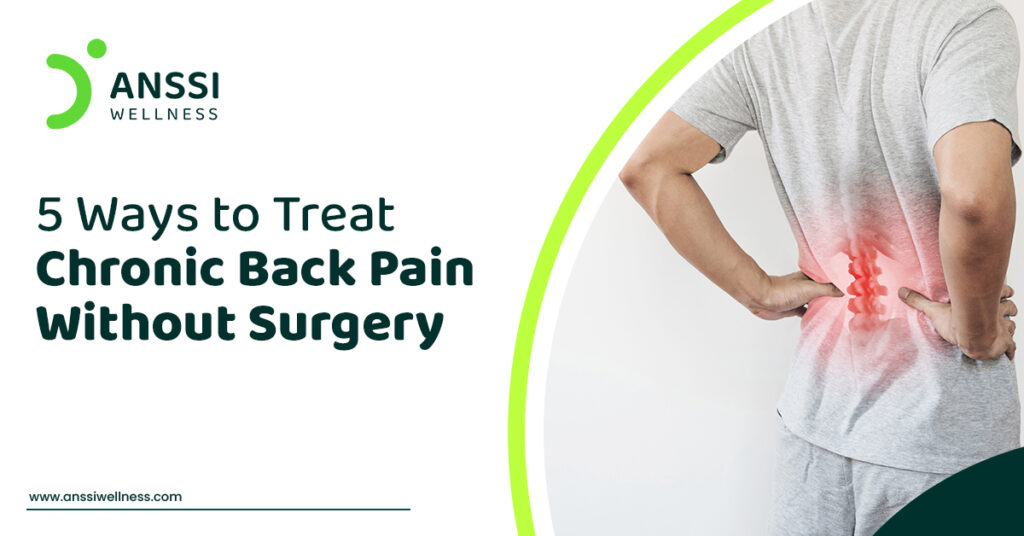Back pain that is experienced for a period of 3 or more months is said to be chronic in nature. It may be intermittent, providing relief for a short period of time before making a comeback. Let’s learn more about the chronic back pain and the different ways to treat it.
What Are the Common Causes of Chronic Back Pain?
Following are some of the well-known causes of chronic back pain:
- Improper posture
- Spinal arthritis
- Spinal disc problems
- Spine joint/muscle issues
- Spinal stenosis
What Are the Symptoms of Chronic Back Pain?
Common symptoms of chronic back pain include:
- Constant back pain
- Swelling/inflammation in the back region
- Pain in the legs and knees
- Numbness around the buttocks, genitals, and anus
- Experiencing problems with urination
Non-Surgical Treatments for Chronic Back Pain
Any type of surgery involves a lot of risks and side effects. Hence, it’s well-advised to opt for non-surgical treatments instead of surgery. Check out some of the non-surgical treatments available for chronic back pain:
Non-Surgical Spinal Decompression Treatment
It is a highly cost-effective and potent treatment for chronic back pain caused due to issues with the spinal discs. The non-surgical spinal decompression treatment has successfully treated over 3500 patients globally so far.
Such treatment includes:
✅ Advanced Spinal Decompression Technology
✅ Very Effective Treatment as per the USA Journal of Clinical Research
✅ Safe without any Risks Associated with Surgery or Anaesthesia
✅ Zero Side Effects
✅ No Medication and Hospitalisation required
Physical Therapy
Physical therapy may help treat some instances of chronic back pain, such as those that involve poor posture as one of the reasons behind it.
It may comprise:
- Correcting posture
- Assessing the limits of pain tolerance
- Flexibility and stretching exercises
- Aerobic exercises
- Core strengthening exercises
Mindfulness and Meditation
Chronic back pain can have a profound negative effect in a physical as well as emotional sense. However, yoga, meditation, and other cognitive and relaxation techniques may help limit this adverse impact.
Lifestyle Modifications
People with chronic back pain can make adjustments in their daily lifestyle to avoid aggravating the pain and/or the underlying condition causing it.
Diet
It is important to avoid consumption of foods that are inflammatory in nature, such as highly processed foods and foods that contain huge amounts of refined sugars and trans fats.
Managing Your Chronic Back Pain
Chronic back pain can very well be treated through non-surgical treatments. It’s important to detect the health condition causing it for a swift and appropriate treatment. The Non-Surgical Spinal Decompression Treatment is an effective treatment available for chronic back pain. To know more about it, schedule an appointment with a Spine Specialist at your nearest ANSSI Wellness Center.
About ANSSI:
ANSSI Wellness focuses on improving the quality of life for patients suffering from spinal issues, aiming to provide relief where other conventional treatments have failed. Through advanced non-surgical spinal decompression treatment, ANSSI is committed to helping patients avoid surgery and recover in a safe, effective, and compassionate environment. Connect with ANSSI Wellness on LinkedIn, Instagram, and Facebook for expert guidance.
FAQs
The word chronic is generally attributed to back pain that persists for a period of 3 or more months.
Yes, chronic back pain can be successfully treated with the help of numerous non-surgical therapies.
No, it isn’t normal to experience back pain on a daily basis. You should contact a spine expert if your back pain doesn’t go away within a couple of weeks.
Reference:
Gionis, Thomas A., and Eric Groteke. “Spinal decompression.” Orthopedic technology review 5 (2003): 36-39. https://comfortrac.net/wp-content/uploads/2015/11/Spinal_Decompression.pdf
Daniel, Dwain M. “Non-surgical spinal decompression therapy: does the scientific literature support efficacy claims made in the advertising media?.” Chiropractic & Osteopathy 15.1 (2007): 1-5. https://chiromt.biomedcentral.com/articles/10.1186/1746-1340-15-7



